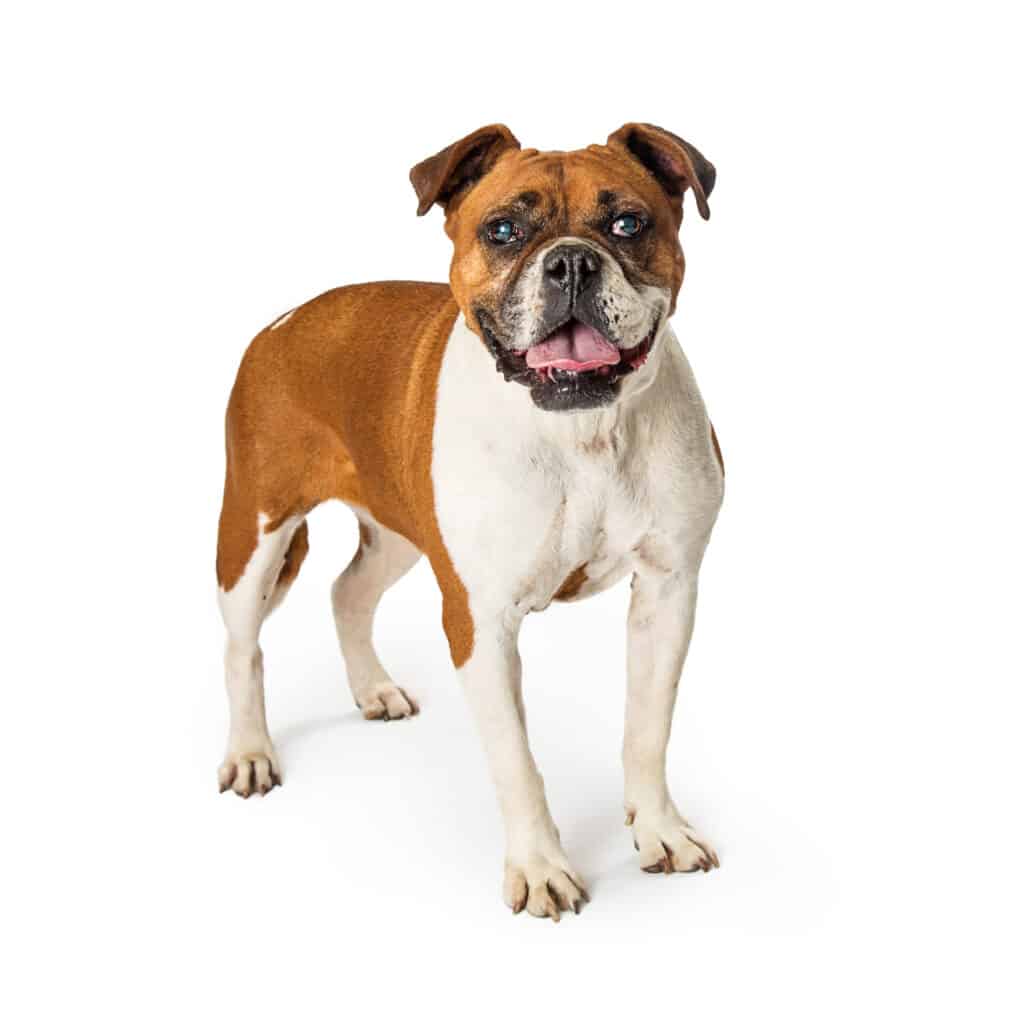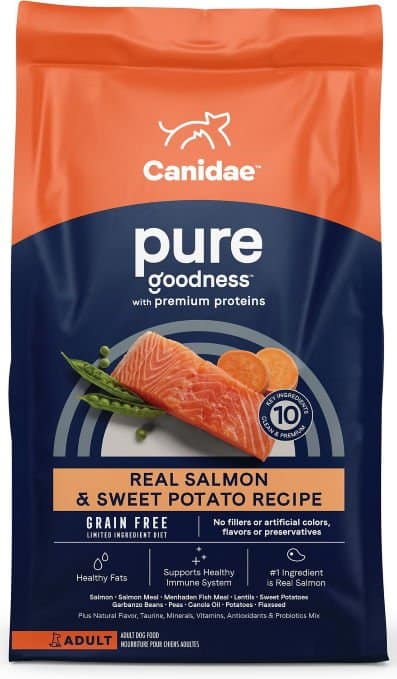Valley Bulldog
Canis familiaris
These dogs cannot swim well because of their stocky build and short legs.
Advertisement
Valley Bulldog Scientific Classification
- Kingdom
- Animalia
- Phylum
- Chordata
- Class
- Mammalia
- Order
- Carnivora
- Family
- Canidae
- Genus
- Canis
- Scientific Name
- Canis familiaris
Read our Complete Guide to Classification of Animals.
Valley Bulldog Conservation Status
Valley Bulldog Facts
- Name Of Young
- Puppies
- Group Behavior
- Social
- Fun Fact
- These dogs cannot swim well because of their stocky build and short legs.
- Other Name(s)
- Bull Boxer
Valley Bulldog Physical Characteristics
- Color
- Fawn
- Red
- White
- Tan
- Brindle
- Skin Type
- Fur
- Lifespan
- 10-12 years
- Weight
- 50-125
- Height
- 12-25 inches tall
- Age of Sexual Maturity
- 7-10 months
- Age of Weaning
- 5-6 weeks
- Aggression
- Low
Valley Bulldog as a Pet:
- General Health
- Energy Level
- Shedability
- Trainability
- Intelligence
- Tendency to Chew
- Size
- Family and kid friendliness
- Yappiness / Barking
- High
- Hypoallergenic
- Yes
- Separation Anxiety
- High
- Preferred Temperature
- Average climate
- Exercise Needs
- Moderate
- Friendly With Other Dogs
- Moderate
- Pure bred cost to own
- cost anywhere from $500 to $1900
- Dog group
- Non-sporting
- Male weight
- 50-125 lbs
- Female weight
- 50-125 lbs
This post may contain affiliate links to our partners like Chewy, Amazon, and others. Purchasing through these helps us further the A-Z Animals mission to educate about the world's species.
View all of the Valley Bulldog images!
The Valley Bulldog originated in Nova Scotia, situated in Canada. This breed has a mixture between a boxer and an English bulldog. Although a rare breed, they are still known to be very popular and a common sight. These dogs have been around since the mid-1990s, but some believe the Valley bulldog may have been around a little longer.
The Different Types of Bulldog Breeds
There are eleven types of bulldog breeds, namely:
- American bulldog
- French bulldog
- English bulldog
- Australian bulldog
- Olde English bulldog
- Victorian bulldog
- Catahoula bulldog
- Ca de Bou bulldog
- Alapaha Blue-Blood bulldog
- Bullmastiff
- Red-Tiger bulldog
Fun Facts About the Valley Bulldog Dog
- The Bull-Boxer is another name used instead of the Valley bulldog.
- These dogs cannot swim well because of their stocky build and short legs.
- Their salivary glands produce more saliva when they smell tasty treats, especially when dinner is prepared.
Pros and Cons of Owning a Valley Bulldog
| Pros | Cons |
|---|---|
| Not aggressive: they can be boisterous at times, but the Valley bulldog is definitely not aggressive. They have a more playful and loving temperament. | Not pet friendly: they are not very fond of other animals, especially if a cat is in their presence. If other dogs are around, it takes the Valley bulldog a bit of time before they show any friendliness towards them. |
| Effortless grooming: their fur consists of short hair strands, so their coats don’t require cutting at the groomers. They need occasional flea treatments and regular ear checks to prevent infections. | Bark a lot: Depending on their day, they can be very vocal as they bark and sometimes howl. Their barking can mean they are trying to alert you about something, or when left alone, they will bark until you get back home as they often suffer from separation anxiety. |
| Kid-friendly: if you have children, the Valley bulldog will make for the perfect fit as they are very protective and gentle when around little ones. | Prone to obesity: there is a high chance your Valley bulldog could pick up weight quickly if its diet is not well-balanced. They should not have more than two meals daily and keep snacks limited to prevent weight gain. |
The Best Dog Food for the Valley Bulldog
The Valley bulldog stomach cannot process foods that contain high levels of grains which contain starchy carbohydrates such as:
- Legumes
- Peas
- Lentils
Because these dogs struggle with food allergies and weight gain, it is essential to provide them with dog food that has high nutritional value and no additives to prevent any issues, such as
- Ear inflammation
- Itching skin
- Gas
- Diarrhea
At A-Z Animals, the best food option for your Valley bulldog is Canidae pure limited ingredient premium Adult dry dog food, Salmon, and Sweet Potato flavor. This brand of dog food consists of antioxidants, probiotics, vitamins, and minerals, giving your dog a healthy balanced diet as well as a happy tummy.
- Canidae PURE Salmon and Sweet Potato Recipe Dry Dog Food
- Contains real salmon, menhaden, fish meal, peas and sweet potatoes
- 10 or fewer key ingredients for sensitive dogs
- Antioxidants and probiotics to support healthy digestion and and immune health
- Vitamins and minerals to support healthy joints, skin and coat
Valley Bulldog Weight and Size
Their compact and muscular body is medium in size, where both male and female dogs have a healthy weight of 50-125 pounds. The body of the Valley bulldog is 16-25 inches long and approximately 12-25 inches tall.
Valley Bulldog Health Issues
Although Valley bulldogs are a healthy breed, they can be affected by these health issues such as:
- Difficulty breathing
- Skin problems
- Hip dysplasia
At times they can struggle to breathe properly because their noses are short, resulting in narrow nasal passages causing snoring and difficulty breathing.
They have susceptible skin, so when grooming them, keep in mind to dry their ears properly to prevent bacteria from growing and causing skin infections.
Because their body is muscular and dense, they need regular check-ups at the vet. They are prone to suffer from hip dysplasia, which causes uncomfortable pain and inability to walk as arthritis starts to set in.

The Valley bulldog has a boisterous personality and moderate exercise needs.
©Mary Swift/Shutterstock.com
Valley Bulldog Temperament
They can be fun and silly up until about a year; after that they will start settling down a little and become calmer and more laid-back. However, they still participate in the odd clownish moments when running and playing outside, and boy, do they keep you entertained.
This breed is famous for their boisterous personality, where they will run around the house at full speed for the thrill of excitement; for some reason, this does entertain them. The Valley bulldog does not like to be left alone and will always make sure to be close to its family at all times.
In fact, these dogs always need to be surrounded by love and affection because if they are left alone for long periods, they tend to become uninterested and depressed.
When not clowning around and keeping a watchful eye for strangers, they will lay on their backs waiting for a good old belly scratch. Then, once satisfied, they will make their way to any comfy spot where they can catch up on some sleep and re-energize.
How to Take Care of a Valley Bulldog
If you are not knowledgeable on how to take care of your dog, your most reliable source would be to go to your local veterinarian clinic, which can give you essential information such as health, diet, and grooming.
Grooming
These dogs need to have regular baths to ensure that their coats are clean, which will keep their fur from becoming smelly and oily. In addition, the wrinkles on their face need extra attention as they should be wiped and dried daily to prevent any flare-ups of skin infections and skin sensitivity.
Because their hairs are short and do not shed often, their coats can be brushed weekly to eliminate loose hairs. As for their nails and teeth, it is vital to keep your dog’s nails short and brush their teeth at least once a week to prevent dental decay and plaque build-up.
Training
The Valley bulldog is easily trainable as they are brilliant, picking up on commands quickly but sometimes can have a stubborn streak in them where they refuse to listen to commands. Although wanting to please their owner, they can sometimes become distracted and will roll over and lose interest.
It is important to train this breed, as on occasion, they are known to chew and will chew on anything that looks and feels interesting. This type of behavior can be corrected by using proper training techniques, as this will teach your dog not to chew on any of your belongings and instead choose a chew toy or tasty dog treat.

The Valley bulldog can be stubborn at times but is considered to be easily trained.
©GoodFocused/Shutterstock.com
Exercise
Moderate exercise is needed for this canine because of its short muzzle. As a result, these dogs are unable to get sufficient airflow through their noses, causing grunting and difficulty breathing. A slow walk is recommended as this will get their blood flowing and assist in keeping those pounds at bay.
Your Valley bulldog will appreciate their daily walks in more of a cooler temperature as they don’t do very well in the heat, causing them to overheat and get winded easily. However, if the weather does not play a part and it is too hot, keep them indoors and play a game of tug and war with their favorite chew toy, as this is another excellent form of exercise for your dog.
Puppies
These puppies can be adopted from as young as 12 weeks and cost anywhere from $500 to $1900.

The Valley bulldog is a mix between a boxer and an English bulldog and can reach 50-125 pounds in weight when full-grown.
©Touched by light images/Shutterstock.com
Valley Bulldog and Children
The Valley bulldog is a gentle and loving breed that makes for an exceptional playmate for your children. Although if more minor children are around, they should not be left unattended as this dog can be overly excited and could push them over with their strong muscular bodies.
These dogs can be protective over their food, so be extra cautious when children approach them while they eat, as they can growl and might snap at them with a nip of their mouth.
Popular Names for Valley Bulldogs
- Daisy
- Penny
- Coco
- Bailey
- Bruno
- Otis
- Tank
- Chomper
Related Animals
View all 25 animals that start with VValley Bulldog FAQs (Frequently Asked Questions)
What breeds make a Valley bulldog?
The Valley bulldog has a combination of a boxer and an English bulldog.
Are Valley bulldogs hypoallergenic?
They are not hypoallergenic, but because their hairs are short and do not shed often, their coats can be brushed weekly to eliminate loose hairs.
Do Valley bulldogs drool?
Their salivary glands produce more saliva when they smell tasty treats, especially when dinner is prepared.
Thank you for reading! Have some feedback for us? Contact the AZ Animals editorial team.
Sources
- dogtime, Available here: https://dogtime.com/dog-breeds/valley-bulldog#/slide/1
- dogbreedinfo, Available here: https://www.dogbreedinfo.com/valleybulldog.htm
- wagwalking.com, Available here: https://wagwalking.com/breed/valley-bulldog


















